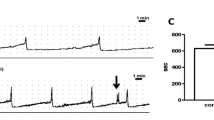Summary
The influence of intravesical administration of PGE2 (1,500 μg) and sulprostone, a PGE2 derivative (1,000 μg) on urodynamic parameters of the lower urinary tract was tested on six healthy female patients. PGE2 and sulprostone significantly decreased the urethral closure pressure at rest. PGE2 increased the detrusor opening pressure as well as the detrusor pressure during maximum flow. Sulprostone, in contrast, slightly decreased these parameters. Both substances caused a strong urgency sensation resulting in an equally reduced bladder capacity and leading to a measurable bladder instability in both cases. This gives rise to the assumption that frequency, urgency and bladder instability may be the result of intravesical relaxation. By 24 h after administration all urodynamic parameters had returned to pretreatment values, thus indicating that long-term changes in urodynamic parameters are not found after either prostaglandin.
Similar content being viewed by others
References
Andersson KE, Henriksson L, Ulmsten U (1978) Effects of prostaglandin E2 applied locally on intravesical and intraurethral pressures in women. Eur Urol 4:366
Bates P, Bradley WE, Glen E, Melchior HJ, Rowan D, Sterling A, Hald T (1976) First report on the standardisation of terminology of lower urinary tract function. Br J Urol 48:39
Bates P, Glen E, Griffiths D, Melchior HJ, Rowan D, Sterling A, Zinner N,Hald T (1977) Second report on the standardisation of terminology of lower urinary tract function. Br J Urol 49:207
Bates P, Bradley WE, Glen ES, Griffiths D, Melchior HJ, Rowan D, Sterling A, Hard T (1980) Third report on the standardisation of terminology of lower urinary tract function. Br J Urol 52:348
Beck RP, Armsch D, King C (1976) Results in treating 210 patients with detrusor overactivity incontinence of urine. Am J Obstet Gynecol 125:593
Brown M, Wickham JEA (1969) The urethral pressure profile. Br J Urol 16:211
Bultitude MJ, Hills NH, Shuttleworth KED(1976) Clinical and experimental studies on the action of prostaglandins and their synthesis inhibitors on detrusor muscle in vitro and in vivo. Br J Urol 48:631
Delaere KPJ, Thomas CMG, Moonen WA, Debruyne FMJ (1981) The value of intravesical prostaglandin E2 and F2alpha in women with abnormalities of bladder emptying. Br J Urol 53:306
Grünberger W, Tulzer H (1981) Zur Therapie der postoperativen Harnverhaltung mit Prostaglandin. Geburtshilfe Frauenheilkd 41:20
Hess HJ, Bindra SJ, Constantine JW, Elger W, Loge O, Schillinger E, Losert W (1977) Pharmacology of 16-phenoxy-w-tetranor PGE2-methylsulfonamide, a tissue selective antifertility prostaglandin. IRCS Med Sci 5:68
Jaschevatzky O, Anderman S, Shalit S, Ellenbogen A, Grunstein S (1983) PGF2alpha for prevention of urinary retention after vaginal hysterectomy. Obstet Gynecol 66:245
Karim SMM, Rao B, Ratnam SS, Prasad RNV, Wong KM (1977) Menstrual induction-termination of early pregnancy with a new prostaglandin analogue SHB286. IRCS Med Sci 5:25
Schmidt-Gollwitzer K, Schüßler B, Elger W, Schmidt-Gollwitzer M (1980) Improvement in artifiaial second-trimester abortion with a new tissue-selective prostaglandin E2-derivative. Am J Obstet Gynecol 137:867
Schüßler B, Schmidt-Gollwitzer K, Schmidt-Gollwitzer M (1980) Vergleich zweier intramuskulär anwendbarer Prostglandinanaloga zur Aborteinleitung im I. Schwangerschaftstrimenon. Gynakol Rundsch 20:102
Schüßler B, Alloussi S (1981) Beeinflussung der Harnblasenfunktion durch Prostaglandine: Anwendungsmöglichkeiten in der Gynäkologie? In: Hepp H, Schüßler B (eds) Prostaglandine in Gynäkologie und Geburtshilfe. Springer, Berlin Heidelberg New York, p 152
Schüßler B, Hoppe T, Gödtel HH, Alloussi S, Hannappel J (1983) In vitro and in vivo studies on the mode of action of PGE2 and Sulprostone at the bladder neck. In: Schäfer W, Hannappel J, Lutzeyer W (eds)Proceedings of the 2nd Joint Meeting ICS/UDS, p 264
Stanton SL, Cardozo LB, Kerr-Wilson R (1979) Treatment of delayed onset of spontaneous voiding after surgery for incontinence. Urology 13:494
Sutherst JR, Brown M (1978) The effect on the bladder pressure of sudden entry of fluid into the posterior urethra. Br J Urol 50:406
Vaidynathan S, Rao K, Rao MS, Sharma PG, Prakash BS (1983) Intravesical application of a 15 (S) 15 methyl prostaglandin F2alpha suppository in females with chronic urinary retention. IRCS Med Sci 11:921
Wagner G, Husslein P, Enzelsberger H (1985) is PGE2 really of therapeutic value for postoperative urinary retention? Results of a prospectively randomized double-blind study. Am J Obstet Gynecol 151:375
Author information
Authors and Affiliations
Additional information
This work was supported by the Upjohn Company, Heppenheim, and the Schering AG, Berlin
Rights and permissions
About this article
Cite this article
Schüßler, B. Comparison of the mode of action of prostaglandin E2 (PGE2) and sulprostone, a PGE2-derivative, on the lower urinary tract in healthy women. Urol. Res. 18, 349–352 (1990). https://doi.org/10.1007/BF00300786
Accepted:
Issue Date:
DOI: https://doi.org/10.1007/BF00300786




